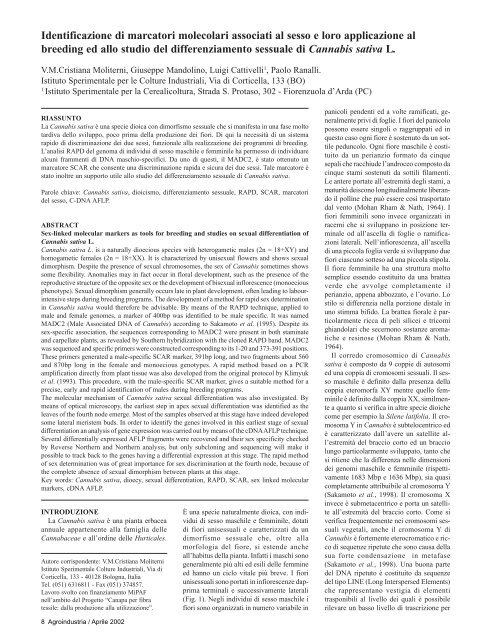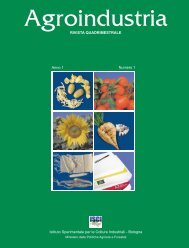Istituto Sperimentale per le Colture Industriali - Bologna ... - isci.it
Istituto Sperimentale per le Colture Industriali - Bologna ... - isci.it
Istituto Sperimentale per le Colture Industriali - Bologna ... - isci.it
You also want an ePaper? Increase the reach of your titles
YUMPU automatically turns print PDFs into web optimized ePapers that Google loves.
Identificazione di marcatori mo<strong>le</strong>colari associati al sesso e loro applicazione al<br />
breeding ed allo studio del differenziamento sessua<strong>le</strong> di Cannabis sativa L.<br />
V.M.Cristiana Mol<strong>it</strong>erni, Giuseppe Mandolino, Luigi Cattivelli 1 , Paolo Ranalli.<br />
<strong>Ist<strong>it</strong>uto</strong> <strong>S<strong>per</strong>imenta<strong>le</strong></strong> <strong>per</strong> <strong>le</strong> <strong>Colture</strong> <strong>Industriali</strong>, Via di Corticella, 133 (BO)<br />
1 <strong>Ist<strong>it</strong>uto</strong> <strong>S<strong>per</strong>imenta<strong>le</strong></strong> <strong>per</strong> la Cerealicoltura, Strada S. Protaso, 302 - Fiorenzuola d’Arda (PC)<br />
RIASSUNTO<br />
La Cannabis sativa è una specie dioica con dimorfismo sessua<strong>le</strong> che si manifesta in una fase molto<br />
tardiva dello sviluppo, poco prima della produzione dei fiori. Di qui la necess<strong>it</strong>à di un sistema<br />
rapido di discriminazione dei due sessi, funziona<strong>le</strong> alla realizzazione dei programmi di breeding.<br />
L’analisi RAPD del genoma di individui di sesso maschi<strong>le</strong> e femmini<strong>le</strong> ha <strong>per</strong>messo di individuare<br />
alcuni frammenti di DNA maschio-specifici. Da uno di questi, il MADC2, è stato ottenuto un<br />
marcatore SCAR che consente una discriminazione rapida e sicura dei due sessi. Ta<strong>le</strong> marcatore è<br />
stato inoltre un supporto uti<strong>le</strong> allo studio del differenziamento sessua<strong>le</strong> di Cannabis sativa.<br />
Paro<strong>le</strong> chiave: Cannabis sativa, dioicismo, differenziamento sessua<strong>le</strong>, RAPD, SCAR, marcatori<br />
del sesso, C-DNA AFLP.<br />
ABSTRACT<br />
Sex-linked mo<strong>le</strong>cular markers as tools for breeding and studies on sexual differentiation of<br />
Cannabis sativa L.<br />
Cannabis sativa L. is a naturally dioecious species w<strong>it</strong>h heterogametic ma<strong>le</strong>s (2n = 18+XY) and<br />
homogametic fema<strong>le</strong>s (2n = 18+XX). It is characterized by unisexual flowers and shows sexual<br />
dimorphism. Desp<strong>it</strong>e the presence of sexual chromosomes, the sex of Cannabis sometimes shows<br />
some f<strong>le</strong>xibil<strong>it</strong>y. Anomalies may in fact occur in floral development, such as the presence of the<br />
reproductive structure of the oppos<strong>it</strong>e sex or the development of bisexual inflorescence (monoecious<br />
phenotype). Sexual dimorphism generally occurs late in plant development, often <strong>le</strong>ading to labourintensive<br />
steps during breeding programs. The development of a method for rapid sex determination<br />
in Cannabis sativa would therefore be advisab<strong>le</strong>. By means of the RAPD technique, applied to<br />
ma<strong>le</strong> and fema<strong>le</strong> genomes, a marker of 400bp was identified to be ma<strong>le</strong> specific. It was named<br />
MADC2 (Ma<strong>le</strong> Associated DNA of Cannabis) according to Sakamoto et al. (1995). Desp<strong>it</strong>e <strong>it</strong>s<br />
sex-specific association, the sequences corresponding to MADC2 were present in both staminate<br />
and carpellate plants, as revea<strong>le</strong>d by Southern hybridization w<strong>it</strong>h the cloned RAPD band. MADC2<br />
was sequenced and specific primers were constructed corresponding to <strong>it</strong>s 1-20 and 373-391 pos<strong>it</strong>ions.<br />
These primers generated a ma<strong>le</strong>-specific SCAR marker, 391bp long, and two fragments about 560<br />
and 870bp long in the fema<strong>le</strong> and monoecious genotypes. A rapid method based on a PCR<br />
amplification directly from plant tissue was also developed from the original protocol by Klimyuk<br />
et al. (1993). This procedure, w<strong>it</strong>h the ma<strong>le</strong>-specific SCAR marker, gives a su<strong>it</strong>ab<strong>le</strong> method for a<br />
precise, early and rapid identification of ma<strong>le</strong>s during breeding programs.<br />
The mo<strong>le</strong>cular mechanism of Cannabis sativa sexual differentiation was also investigated. By<br />
means of optical microscopy, the earliest step in apex sexual differentiation was identified as the<br />
<strong>le</strong>aves of the fourth node emerge. Most of the samp<strong>le</strong>s observed at this stage have indeed developed<br />
some lateral meristem buds. In order to identify the genes involved in this earliest stage of sexual<br />
differentiation an analysis of gene expression was carried out by means of the cDNA AFLP technique.<br />
Several differentially expressed AFLP fragments were recovered and their sex specific<strong>it</strong>y checked<br />
by Reverse Northern and Northern analysis, but only subcloning and sequencing will make <strong>it</strong><br />
possib<strong>le</strong> to track back to the genes having a differential expression at this stage. The rapid method<br />
of sex determination was of great importance for sex discrimination at the fourth node, because of<br />
the comp<strong>le</strong>te absence of sexual dimorphism between plants at this stage.<br />
Key words: Cannabis sativa, dioecy, sexual differentiation, RAPD, SCAR, sex linked mo<strong>le</strong>cular<br />
markers, cDNA AFLP.<br />
INTRODUZIONE<br />
La Cannabis sativa è una pianta erbacea<br />
annua<strong>le</strong> appartenente alla famiglia del<strong>le</strong><br />
Cannabaceae e all’ordine del<strong>le</strong> Hurtica<strong>le</strong>s.<br />
Autore corrispondente: V.M.Cristiana Mol<strong>it</strong>erni<br />
<strong>Ist<strong>it</strong>uto</strong> <strong>S<strong>per</strong>imenta<strong>le</strong></strong> <strong>Colture</strong> <strong>Industriali</strong>, Via di<br />
Corticella, 133 - 40128 <strong>Bologna</strong>, Italia<br />
Tel. (051) 6316811 - Fax (051) 374857.<br />
Lavoro svolto con finanziamento MiPAF<br />
nell’amb<strong>it</strong>o del Progetto “Canapa <strong>per</strong> fibra<br />
tessi<strong>le</strong>: dalla produzione alla utilizzazione”.<br />
8 Agroindustria / Apri<strong>le</strong> 2002<br />
È una specie naturalmente dioica, con individui<br />
di sesso maschi<strong>le</strong> e femmini<strong>le</strong>, dotati<br />
di fiori unisessuali e caratterizzati da un<br />
dimorfismo sessua<strong>le</strong> che, oltre alla<br />
morfologia del fiore, si estende anche<br />
all’hab<strong>it</strong>us della pianta. Infatti i maschi sono<br />
generalmente più alti ed esili del<strong>le</strong> femmine<br />
ed hanno un ciclo v<strong>it</strong>a<strong>le</strong> più breve. I fiori<br />
unisessuali sono portati in infiorescenze dapprima<br />
terminali e successivamente laterali<br />
(Fig. 1). Negli individui di sesso maschi<strong>le</strong> i<br />
fiori sono organizzati in numero variabi<strong>le</strong> in<br />
panicoli pendenti ed a volte ramificati, generalmente<br />
privi di foglie. I fiori del panicolo<br />
possono essere singoli o raggruppati ed in<br />
questo caso ogni fiore è sostenuto da un sotti<strong>le</strong><br />
peduncolo. Ogni fiore maschi<strong>le</strong> è cost<strong>it</strong>u<strong>it</strong>o<br />
da un <strong>per</strong>ianzio formato da cinque<br />
sepali che racchiude l’androceo composto da<br />
cinque stami sostenuti da sottili filamenti.<br />
Le antere portate all’estrem<strong>it</strong>à degli stami, a<br />
matur<strong>it</strong>à deiscono long<strong>it</strong>udinalmente liberando<br />
il polline che può essere così trasportato<br />
dal vento (Mohan Rham & Nath, 1964). I<br />
fiori femminili sono invece organizzati in<br />
racemi che si sviluppano in posizione termina<strong>le</strong><br />
od all’ascella di foglie o ramificazioni<br />
laterali. Nell’infiorescenza, all’ascella<br />
di una piccola foglia verde si sviluppano due<br />
fiori ciascuno sotteso ad una piccola stipola.<br />
Il fiore femmini<strong>le</strong> ha una struttura molto<br />
semplice essendo cost<strong>it</strong>u<strong>it</strong>o da una brattea<br />
verde che avvolge comp<strong>le</strong>tamente il<br />
<strong>per</strong>ianzio, appena abbozzato, e l’ovario. Lo<br />
stilo si differenzia nella porzione dista<strong>le</strong> in<br />
uno stimma bifido. La brattea fiora<strong>le</strong> è particolarmente<br />
ricca di peli silicei e tricomi<br />
ghiandolari che secernono sostanze aromatiche<br />
e resinose (Mohan Rham & Nath,<br />
1964).<br />
Il corredo cromosomico di Cannabis<br />
sativa è composto da 9 coppie di autosomi<br />
ed una coppia di cromosomi sessuali. Il sesso<br />
maschi<strong>le</strong> è defin<strong>it</strong>o dalla presenza della<br />
coppia eteromorfa XY mentre quello femmini<strong>le</strong><br />
è defin<strong>it</strong>o dalla coppia XX, similmente<br />
a quanto si verifica in altre specie dioiche<br />
come <strong>per</strong> esempio la Si<strong>le</strong>ne latifolia. Il cromosoma<br />
Y in Cannabis è subtelocentrico ed<br />
è caratterizzato dall’avere un satell<strong>it</strong>e all’estrem<strong>it</strong>à<br />
del braccio corto ed un braccio<br />
lungo particolarmente sviluppato, tanto che<br />
si r<strong>it</strong>iene che la differenza nel<strong>le</strong> dimensioni<br />
dei genomi maschi<strong>le</strong> e femmini<strong>le</strong> (rispettivamente<br />
1683 Mbp e 1636 Mbp), sia quasi<br />
comp<strong>le</strong>tamente attribuibi<strong>le</strong> al cromosoma Y<br />
(Sakamoto et al., 1998). Il cromosoma X<br />
invece è submetacentrico e porta un satell<strong>it</strong>e<br />
all’estrem<strong>it</strong>à del braccio corto. Come si<br />
verifica frequentemente nei cromosomi sessuali<br />
vegetali, anche il cromosoma Y di<br />
Cannabis è fortemente eterocromatico e ricco<br />
di sequenze ripetute che sono causa della<br />
sua forte condensazione in metafase<br />
(Sakamoto et al., 1998). Una buona parte<br />
del DNA ripetuto è cost<strong>it</strong>u<strong>it</strong>o da sequenze<br />
del tipo LINE (Long Inters<strong>per</strong>sed E<strong>le</strong>ments)<br />
che rappresentano vestigia di e<strong>le</strong>menti<br />
trasponibili al livello dei quali è possibi<strong>le</strong><br />
ri<strong>le</strong>vare un basso livello di trascrizione <strong>per</strong>



